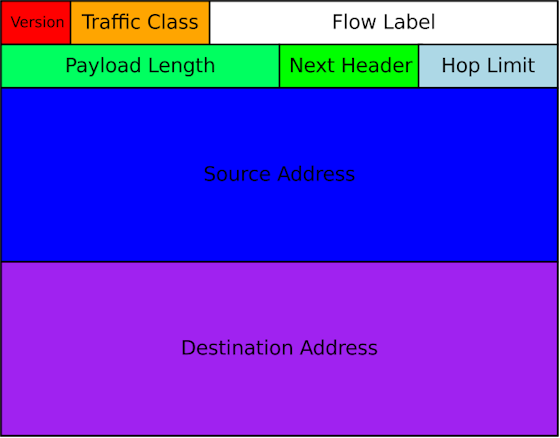Internet Protocol version 6 (IPv6) is a version of the Internet Protocol (IP). It is designed to succeed the Internet Protocol version 4 (IPv4). The Internet operates by transferring data between hosts in small packets that are independently routed across networks as specified by an international communications protocol known as the Internet Protocol.
Each host or computer on the Internet requires an IP address in order to communicate. The growth of the Internet has created a need for more addresses than are possible with IPv4. IPv6 was developed by the Internet Engineering Task Force (IETF) to deal with this long-anticipated IPv4 address exhaustion, and is described in Internet standard document RFC 2460, published in December 1998. Like IPv4, IPv6 is an internet-layer protocol for packet-switched internetworking and provides end-to-end datagram transmission across multiple IP networks. While IPv4 allows 32 bits for an Internet Protocol address, and therefore has 232 (4,294,967,296) possible addresses, IPv6 uses 128-bit addresses, for an address space of 2128 (approximately 340 undecillion or 3.4×1038) addresses. This expansion allows for many more devices and users on the internet as well as extra flexibility in allocating addresses and efficiency for routing traffic. It also eliminates the primary need for network address translation (NAT), which gained widespread deployment as an effort to alleviate IPv4 address exhaustion.
IPv6 also implements additional features not present in IPv4. It simplifies aspects of address assignment (stateless address autoconfiguration), network renumbering and router announcements when changing Internet connectivity providers. The IPv6 subnet size has been standardized by fixing the size of the host identifier portion of an address to 64 bits to facilitate an automatic mechanism for forming the host identifier from link-layer media addressing information (MAC address). Network security is also integrated into the design of the IPv6 architecture, and the IPv6 specification specifies IPsec as a fundamental interoperability requirement.
The last top level (/8) block of free IPv4 addresses was assigned in February 2011 by IANA to the 5 RIRs, although many free addresses still remain in most assigned blocks and RIRs will continue with standard policy until it is at its last /8. After that, only 1024 addresses (a /22) are made available from the RIR for each LIR – currently, only APNIC has already reached this stage. While many operating systems in commercial, business, and home consumer environments can communicate on an IPv6 network, IPv6 does not implement interoperability features with IPv4, and creates essentially a parallel, independent network. Exchanging traffic between the two networks requires special translator gateways, but modern computer operating systems implement dual-protocol software for transparent access to both networks either natively or using a tunneling protocol such as 6to4, 6in4, or Teredo. In December 2010, despite marking its 12th anniversary as a Standards Track protocol, IPv6 was only in its infancy in terms of general worldwide deployment. A 2008 study by Google Inc. indicated that penetration was still less than one percent of Internet-enabled hosts in any country at that time.
Motivation and origins
IPv4
The first publicly used version of the Internet Protocol, Version 4 (IPv4), provides an addressing capability of 232 or approximately 4.3 billion addresses. Address exhaustion was not initially a concern in IPv4 as this version was originally presumed to be an internal test within ARPA, and not intended for public use.
The decision to put a 32-bit address space on there was the result of a year's battle among a bunch of engineers who couldn't make up their minds about 32, 128, or variable-length. And after a year of fighting, I said--I'm now at ARPA, I'm running the program, I'm paying for this stuff, I'm using American tax dollars, and I wanted some progress because we didn't know if this was going to work. So I said: OK, it's 32-bits. That's enough for an experiment; it's 4.3 billion terminations. Even the Defense Department doesn't need 4.3 billion of everything and couldn't afford to buy 4.3 billion edge devices to do a test anyway. So at the time I thought we were doing an experiment to prove the technology and that if it worked we'd have opportunity to do a production version of it. Well, it just escaped! It got out and people started to use it, and then it became a commercial thing. So this [IPv6] is the production attempt at making the network scalable.
—Vint Cerf, Google IPv6 Conference 2008
During the first decade of operation of the Internet (by the late 1980s), it became apparent that methods had to be developed to conserve address space. In the early 1990s, even after the redesign of the addressing system using a model, it became clear that this would not suffice to prevent IPv4 address exhaustion, and that further changes to the Internet infrastructure were needed.
Working-group proposal
By the beginning of 1992, several proposals appeared and by the end of 1992, the IETF announced a call for white papers. In September 1993, the IETF created a temporary, ad-hoc IP Next Generation (IPng) area to deal specifically with IPng issues. The new area was led by Allison Mankin and Scott Bradner, and had a directorate with 15 engineers from diverse backgrounds for direction-setting and preliminary document review:
The Internet Engineering Task Force adopted the IPng model on July 25, 1994, with the formation of several IPng working groups. By 1996, a series of RFCs was released defining Internet Protocol version 6 (IPv6), starting with RFC 1883. (Version 5 was used by the experimental Internet Stream Protocol.)
It is widely expected that the Internet will use IPv4 alongside IPv6 for the foreseeable future. IPv4-only and IPv6-only nodes cannot communicate directly, and need assistance from an intermediary gateway or must use other transition mechanisms.
Exhaustion of IPv4 addresses
On February 3, 2011, in a ceremony in Miami, the Internet Assigned Numbers Authority (IANA) assigned the last batch of 5 /8 address blocks to the Regional Internet Registries, officially depleting the global pool of completely fresh blocks of addresses. Each of the address blocks represents approximately 16.7 million possible addresses, or over 80 million combined potential addresses.
These addresses could well be fully consumed within three to six months of that time at current rates of allocation. APNIC was the first RIR to exhaust its regional pool on 15 April 2011, except for a small amount of address space reserved for the transition to IPv6, which will be allocated in a much more restricted way.
In 2003, the director of Asia-Pacific Network Information Centre (APNIC), Paul Wilson, stated that, based on then-current rates of deployment, the available space would last for one or two decades. In September 2005, a report by Cisco Systems suggested that the pool of available addresses would exhaust in as little as 4 to 5 years. In 2008, a policy process started for the end-game and post-exhaustion era. In 2010, a daily updated report projected the global address pool exhaustion by the first quarter of 2011, and depletion at the five regional Internet registries before the end of 2011.
Comparison to IPv4
IPv6 specifies a new packet format, designed to minimize packet header processing by routers. Because the headers of IPv4 packets and IPv6 packets are significantly different, the two protocols are not interoperable. However, in most respects, IPv6 is a conservative extension of IPv4. Most transport and application-layer protocols need little or no change to operate over IPv6; exceptions are application protocols that embed internet-layer addresses, such as FTP and NTPv3.
The main advantage of IPv6 over IPv4 is its larger address space. The length of an IPv6 address is 128 bits, compared to 32 bits in IPv4. The address space therefore has 2128 or approximately 3.4×1038 addresses. By comparison, this amounts to approximately 4.8×1028 addresses for each of the seven billion people alive in 2011. In addition, the IPv4 address space is poorly allocated, with approximately 14% of all available addresses utilized. While these numbers are large, it was not the intent of the designers of the IPv6 address space to assure geographical saturation with usable addresses. Rather, the longer addresses simplify allocation of addresses, enable efficient route aggregation, and allow implementation of special addressing features. In IPv4, complex Classless Inter-Domain Routing (CIDR) methods were developed to make the best use of the small address space. The standard size of a subnet in IPv6 is 264 addresses, the square of the size of the entire IPv4 address space. Thus, actual address space utilization rates will be small in IPv6, but network management and routing efficiency is improved by the large subnet space and hierarchical route aggregation.
Renumbering an existing network for a new connectivity provider with different routing prefixes is a major effort with IPv4. With IPv6, however, changing the prefix announced by a few routers can in principle renumber an entire network since the host identifiers (the least-significant 64 bits of an address) can be independently self-configured by a host.

Decomposition of an IPv6 address into its binary form
Packet format
The IPv6 packet is composed of two parts: the packet header and the payload. The header consists of a fixed portion with minimal functionality required for all packets and may contain optional extension to implement special features.
The fixed header occupies the first 40 octets (320 bits) of the IPv6 packet. It contains the source and destination addresses, traffic classification options, a hop counter, and a pointer for extension headers if any. The Next Header field, present in each extension as well, points to the next element in the chain of extensions. The last field points to the upper-layer protocol that is carried in the packet's payload.
Extension headers carry options that are used for special treatment of a packet in the network, e.g., for routing, fragmentation, and for security using the IPsec framework.
The payload can have a size of up to 64KB without special options, or larger with a jumbo payload option in a Hop-By-Hop Options extension header.
Unlike in IPv4, fragmentation is handled only in the end points of a communication session; routers never fragment a packet, and hosts are expected to use Path MTU Discovery to select a packet size that can traverse the entire communications path.

IPv6 packet header.
Deployment
The introduction of Classless Inter-Domain Routing (CIDR) in the Internet routing and IP address allocation methods in 1993 and the extensive use of network address translation (NAT) delayed the inevitable IPv4 address exhaustion, but the final phase of exhaustion started on February 3, 2011. However, despite a decade long development and implementation history as a Standards Track protocol, general worldwide deployment is still in its infancy. As of October 2011, about 3% of domain names and 12% of the networks on the internet have IPv6 protocol support.
Nevertheless, IPv6 has been implemented on all major operating systems in use in commercial, business, and home consumer environments. Since 2008, the domain name system can be used in IPv6 as major web sites like Google, although sometimes with extra configuration. IPv6 was first used in a major world event during the 2008 Summer Olympic Games, the largest showcase of IPv6 technology since the inception of IPv6. Countries like China or the Federal U.S. Government are also starting to require IPv6 capability on their equipment. Finally, modern cellular telephone specifications mandate IPv6 operation and deprecate IPv4 as an optional capability.
Controversy
Privacy extensions are, except for the Windows platform and Mac OS X since 10.7 as well as iOS since version 4.3, not enabled by default. The fact that the unique MAC address is exposed to the Internet and therefore makes devices trackable has led to criticism in various countries. Two actions are necessary to guarantee the same level as with today's IPv4 networks: the client device has the privacy extensions enabled, and the provider dynamically assigns a varying address block to the client device.

